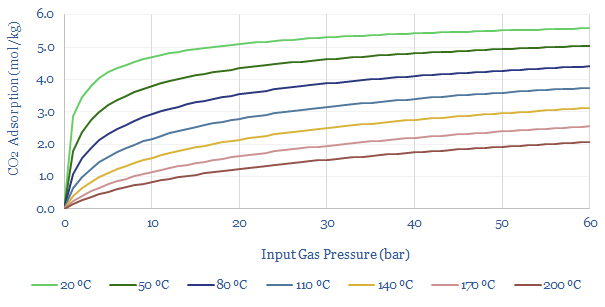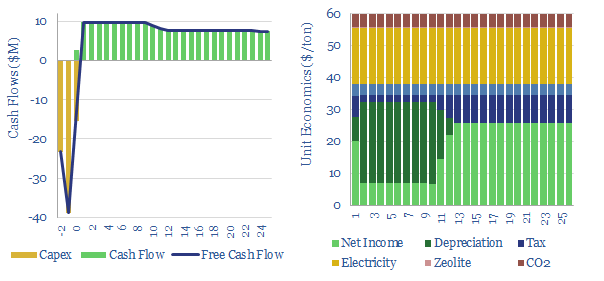Pressure swing adsorption purifies gases according to their differing tendencies to adsorb onto adsorbents under pressure. Pressure swing adsorption costs <$0.1/kg when separating pure hydrogen from the output of reforming reactors, and maybe $2-3/mcf when separating bio-methane from biogas. The cost breakdowns in this data-file include capex, opex, maintenance, zeolite replacement, compression power and CO2 costs.
Pressure swing adsorption compresses a mixture of gases against a solid bed of adsorbents. Different gases ‘adsorb’ onto the surface of this material at different rates, defined by their enthalpy of adsorption (exothermic), partial pressures and temperatures.
This effect is called differential loading. By pulsing gas into a chamber at high pressure, commonly 10-30 bar, gases with lower affinity to the adsorbent can be concentrated in the productate stream, while gas with higher affinity to the adsorbent remain in the chamber until the low affinity gases have been purged and the adsorbent is depressurized.
The physics can be complex, but in the data-file, we have applied some simple equations for multi-component Langmuir isotherms, especially for separating hydrogen out of reforming tail gases, and for CH4/CO2 separations in biogas. We have also played around with some more complex models such as Sips and Toth models (chart below).

But mainly, the data-file is not intended to be overly precise in capturing the physics of pressure swing adsorption, for which we recommend chemical engineering software.
Our goal is to aggregate data-points into the capex, opex, costs, energy use, purity and recovery of PSA processes, as used in present and future industrial applications.
Pressure swing adsorption costs <$0.1/kg when separating hydrogen out of tail gas from the water gas shift reaction of a steam methane reformer, in producing grey or blue hydrogen; and costs $2-3/mcf when separating biomethane out of biogas.
For example, the data imply that the average PSA gas separation will cost $70/Tpa in capex, yield 98% pure product, with 85% recovery from input feeds, and the energy use will average 400 kWh/ton as a mid-point (although it can range from 20-2,000 kWh/ton). The energy costs of pressure swing adsorption are going to depend on pressures used and the energy demands of gas compression.
Please download the data-file to stress-test your own economic assumptions, and for the breakdown of pressure swing adsorption costs. Other techniques for gas separations include amine separations, membrane separations and cryogenic separations.

